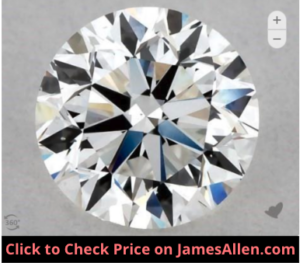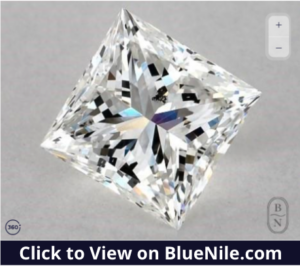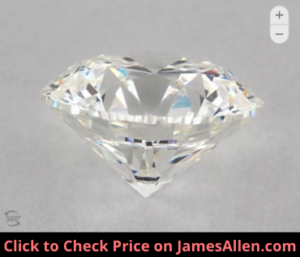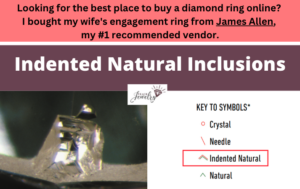
If you’re planning to buy a diamond, you’ve likely come across the topic of inclusions and how they impact a diamond’s clarity.
While there are many flaws that can form within a diamond, indented naturals are a common type that affect its quality.
In this article, you’ll learn all about indented natural diamond inclusions, including how they appear on grading reports, if they can be fixed, how indented naturals compare to chips, and how they influence the price you’ll pay for a diamond.
What are Indented Naturals?
An indented natural inclusion is part of the original rough diamond’s surface that drops below the surface of the polished diamond.
It’s a piece of the rough diamond that wasn’t touched during its polishing, so the inclusion shows you what the diamond looked like in its original form. The depressions are often near the girdle.
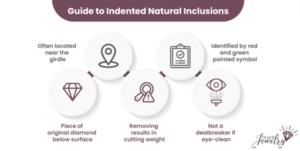
Most clarity characteristics are an imperfection that developed inside the diamond or on its surface during formation, but indented naturals are not the same type of flaw.
Instead, it’s simply part of the diamond that wasn’t removed.
The extent to which an indented natural negatively affects its appearance and brilliance is dependent on size and location.
If it’s small enough to only show 10x magnification, it shouldn’t be a dealbreaker. It won’t result in your diamond having structural issues or a low amount of brilliance.
For example, this diamond has an indented natural, but it can’t be seen with the naked eye.
On the other hand, a diamond with multiple instances of large indented natural inclusions is reason for concern because they’re often visible and cause durability issues.
Indented Naturals on Diamond Grading Reports
Organizations that assess diamonds such as the Gemological Institute of America (GIA) and American Gem Society (AGS) include the type and location of inclusions on its grading reports.
Inclusions affect clarity and light performance, so as a buyer, it’s important you know all the inclusions present and their positions.
Indented naturals are included on grading reports as part of the clarity characteristics plot. The plot features a legend that shows each inclusion symbol and then its corresponding size and location on the diamond.
For example, the below 1.20-carat princess cut diamond comes with a GIA report.
On the grading report, we can see there are indented naturals.
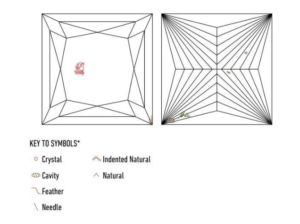
They’re marked by red and green diagonal lines that meet at a point.
Based on this grade, you wouldn’t expect the diamond to appear eye-clean, although the indented naturals may be small enough that they require magnification.
While the grading report provides essential information about the quality of a diamond, I recommend viewing it in-person or through a high-resolution photo online.
That way, you’re not only relying on the clarity plot to decide whether a diamond has too many visible indented natural or other inclusions.
Can They be Fixed?
Diamond cutters have the opportunity to fix indented naturals during the polishing process. The reason small instances aren’t removed is because it would result in cutting more weight from the diamond.
That reduces its overall value.
In fact, cutters used to leave them on the corners to show the maximum amount of the original diamond was used.
The decision on fixing an indented natural is a cost-benefit analysis of whether the diamond would sell for a higher price without the inclusion, but with a lower carat weight, or with the inclusion at a higher carat weight.
For example, this diamond weighs 1.2 carats and costs $8,290.
It also has two occurrences of indented naturals.
This diamond earned the same grades from the GIA but doesn’t have those inclusions.
It’s priced at $6,810.
If the cutter wanted to remove the indented naturals, it might result in reducing the carat weight by 0.1 carats. In our example, that’s a difference of $1,480.
Because tiny indented naturals have no visible impact on the diamond, cutters often decide to leave them in favor for the higher weight.
Indented Naturals vs. Chips
Indented naturals are often confused with a chip, but the two problems are distinct.
A chip in a diamond occurs when a piece of the final, polished diamond breaks off, leaving a gap in its place.
Even though diamonds are the hardest naturally-occurring mineral on Earth, rated a 10 on the Mohs scale of hardness, some diamonds have a weak structure on the cleavage lines where the atoms aren’t tightly bonded together.
In comparing an indented natural to a chip, indented naturals aren’t a piece of the polished diamond breaking off but instead part of the original diamond that has recessed into the stone.
Chips are a type of inclusion that should be avoided because it poses risk for further damage, while the concern about a small intended natural is minimal.
How do They Affect a Diamond’s Price?
All diamond inclusions affect its price, and indented naturals aren’t the exception.
The best way to know how indented natural inclusions affect price is to compare the prices of diamonds that have all the same qualities, except for either the presence or lack of inclusions.
In the example above of the 1.20-carat diamond with indented naturals, its price is $3,780. If we compared that to this diamond with a VVS1 clarity grade, which shows only small pinpoints, its price is $9,180.
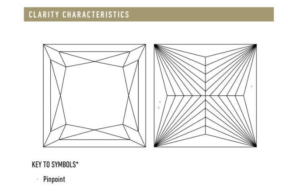
If instead of VVS1 clarity, let’s say we opted for VS1. The diamonds start around $8,000.
It could include indented naturals and other inclusions such as crystals and clouds, but fewer instances result in a higher price compared to the SI2 diamond.
Should You Buy a Diamond with Indented Naturals?
You shouldn’t avoid a diamond on the basis of indented naturals. The key is understanding their size, number, and location, because these qualities are what impact its appearance and brilliance.
If a diamond has minimal inclusions overall, including a small indented natural or two, it can still be a quality diamond. It’ll have a lower price than one without those inclusions, but to the naked eye, you won’t notice the difference.
If you opt for a diamond without any indented naturals or other inclusions, it will come at a premium price. That’s why most buyers choose a diamond with some inclusions that are still eye clean.
It strikes the right balance of a diamond that isn’t filled with imperfections while also not resulting in a high price.
Examine the diamond and its indented naturals in-person or in high-quality photos online, and you’ll know if it’s the right choice for you.

Jacob Clarke
Jacob Clarke is the founder of TeachJewelry.com.
He earned an Applied Jewelry Professional Diploma from the Gemological Institute of America (GIA) and now brings you essential information about diamonds, settings, and more.
Jacob has consulted with leading jewelry brands, and his work has been cited in Clean Origin, Diamond Nexus and industry publications.
He's also a member of the International Gem Society.
He enjoys discussing jewelry with readers, so contact him with any questions at jacob.clarke@teachjewelry.com.

